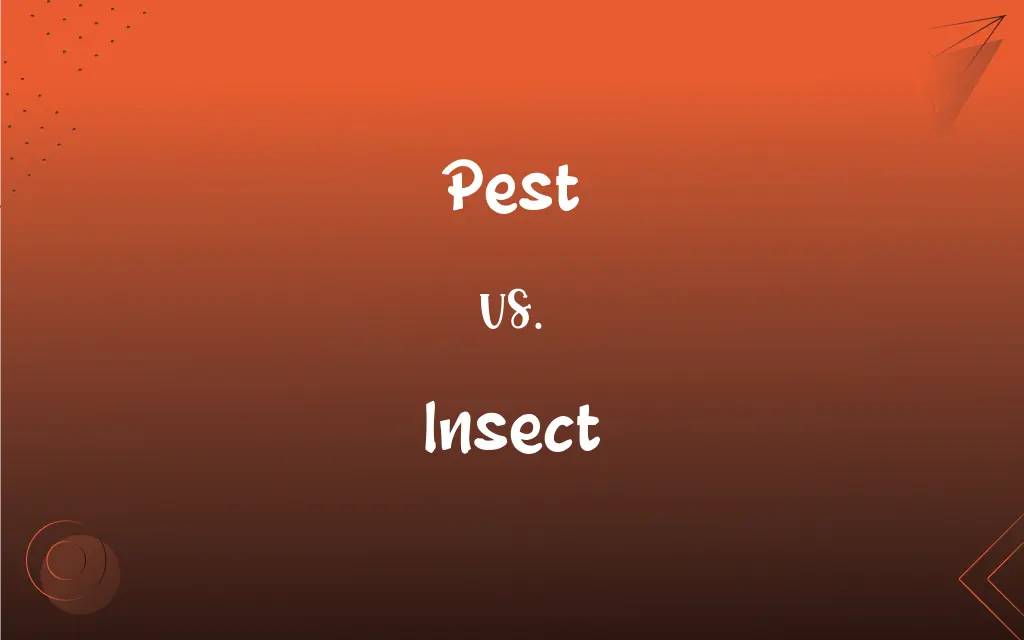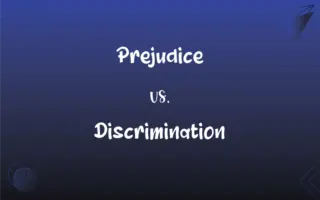Pest vs. Insect: What's the Difference?
Edited by Aimie Carlson || By Harlon Moss || Updated on October 4, 2023
A pest is an unwanted organism causing harm or nuisance; an insect is a small arthropod with six legs and generally three body parts.

Key Differences
A pest is any living organism which is invasive, detrimental, troublesome, or simply unwanted. In contrast, an insect is specifically an arthropod belonging to the class Insecta, characterized by six legs, antennae, and typically having wings.
While all insects can be pests, not all pests are insects. Insects are a category within the animal kingdom, whereas the term "pest" describes an organism's negative or detrimental behavior.
Pests can be plants, mammals, birds, or even microorganisms. On the other hand, insects solely belong to the animal kingdom and are easily recognized by their distinguishing features.
Pests typically interfere with human activities, such as farming or living conditions. While many insects can be pests due to their destructive nature or ability to transmit diseases, numerous insects play beneficial roles in pollination, decomposition, and forming part of the food chain.
Therefore, while the term pest is subjective and based on human perspective and context, the term insect is taxonomical and based on biological classifications.
ADVERTISEMENT
Comparison Chart
Definition
An unwanted organism causing harm or nuisance
An arthropod with six legs and three body parts
Classification
Based on behavior and impact
Based on biological characteristics
Scope
Can be any organism (plants, animals, microbes)
Specific to the class Insecta in the animal kingdom
Examples
Weeds, rats, fungi, bacteria
Bees, ants, butterflies, beetles
Relationship with humans
Typically negative or detrimental
Can be beneficial, neutral, or detrimental
ADVERTISEMENT
Pest and Insect Definitions
Pest
Pest refers to any undesired organism that might cause harm.
The farmer was troubled by the pest affecting his crops.
Insect
Insect is a small arthropod with six legs.
The child was fascinated by the variety of insects in the garden.
Pest
Pest is an organism creating disruption in a particular environment.
Houses near the woods often face pest invasions.
Insect
Insect often has antennae and sometimes wings.
He used a magnifying glass to observe the insect's details.
Pest
Pest denotes an organism harmful to our interests, especially in agriculture.
Regular pest control measures help maintain a clean home.
Insect
Insect belongs to the class Insecta, typically having three body segments.
Studying the anatomy of an insect can be quite intriguing.
Pest
Pest indicates an entity that is a nuisance or harmful.
The city started an initiative to control the pest population.
Insect
Insect is a member of a diverse group of arthropods.
The butterfly is a beautiful example of an insect.
Pest
Pest suggests an organism that interferes with human activities.
Introducing natural predators is one way to manage a pest problem.
Insect
Insect is a creature that undergoes metamorphosis in its life cycle.
The transformation of a caterpillar into a butterfly showcases the life cycle of an insect.
Pest
An annoying person or thing; a nuisance.
Insect
Any of various other small, chiefly arthropod animals, such as spiders, centipedes, or ticks, usually having many legs. Not in scientific use.
Pest
An organism, typically an insect, that sickens or annoys humans, hampers human activities, damages crops or food products, harms livestock, or causes damage to buildings.
Insect
An insignificant or contemptible person.
Pest
A deadly epidemic disease; a pestilence.
Pest
A pestilence, i.e. a deadly epidemic, a deadly plague.
FAQs
Is a spider a pest or an insect?
A spider can be a pest if it's unwanted, but it's not an insect; it's an arachnid.
Are all insects pests?
No, while some insects can be pests, many are beneficial or neutral to human interests.
Are all pests harmful to humans?
Not all pests are directly harmful to humans; some might harm crops or property but not pose a direct threat to human health.
How is an insect defined in terms of body structure?
An insect typically has six legs, antennae, three body segments, and often wings.
What kind of problems do pests usually cause?
Pests can cause damage to crops, transmit diseases, damage property, or simply be a nuisance.
What's a defining feature of insects?
One defining feature of insects is that they have six legs.
Is the term "pest" specific to any particular type of organism?
No, the term "pest" is broad and can apply to any organism, from plants to microbes to animals, that's considered undesirable.
Can a pest be beneficial in a different context?
Yes, what is considered a pest in one context might be beneficial or neutral in another.
What's the primary difference between pest and insect in usage?
"Pest" denotes undesirability based on impact, while "insect" is a taxonomical term based on biological features.
What does "pest" typically refer to?
Pest generally refers to any unwanted organism that causes harm or is a nuisance.
How many legs does an insect typically have?
An insect typically has six legs.
Why are some insects considered pests?
Some insects are considered pests because they damage crops, spread diseases, or invade living spaces.
Do all insects have wings?
No, while many insects have wings, not all of them do.
How can one differentiate between a beneficial insect and a pest?
It often depends on context; an insect beneficial for pollination might be a pest in another context if it damages crops.
Can an organism be both an insect and a pest?
Yes, if an insect is causing harm or is unwanted, it can be considered a pest.
Are bees insects or pests?
Bees are insects. While they can sometimes be considered pests, they play crucial roles in pollination and the ecosystem.
Can pests be controlled without chemicals?
Yes, there are various biological and non-chemical methods to control pests.
Do all insects undergo metamorphosis?
Most insects undergo some form of metamorphosis, but the type and extent can vary.
Can plants be considered pests?
Yes, invasive or unwanted plants can also be termed pests.
About Author
Written by
Harlon MossHarlon is a seasoned quality moderator and accomplished content writer for Difference Wiki. An alumnus of the prestigious University of California, he earned his degree in Computer Science. Leveraging his academic background, Harlon brings a meticulous and informed perspective to his work, ensuring content accuracy and excellence.
Edited by
Aimie CarlsonAimie Carlson, holding a master's degree in English literature, is a fervent English language enthusiast. She lends her writing talents to Difference Wiki, a prominent website that specializes in comparisons, offering readers insightful analyses that both captivate and inform.






































































